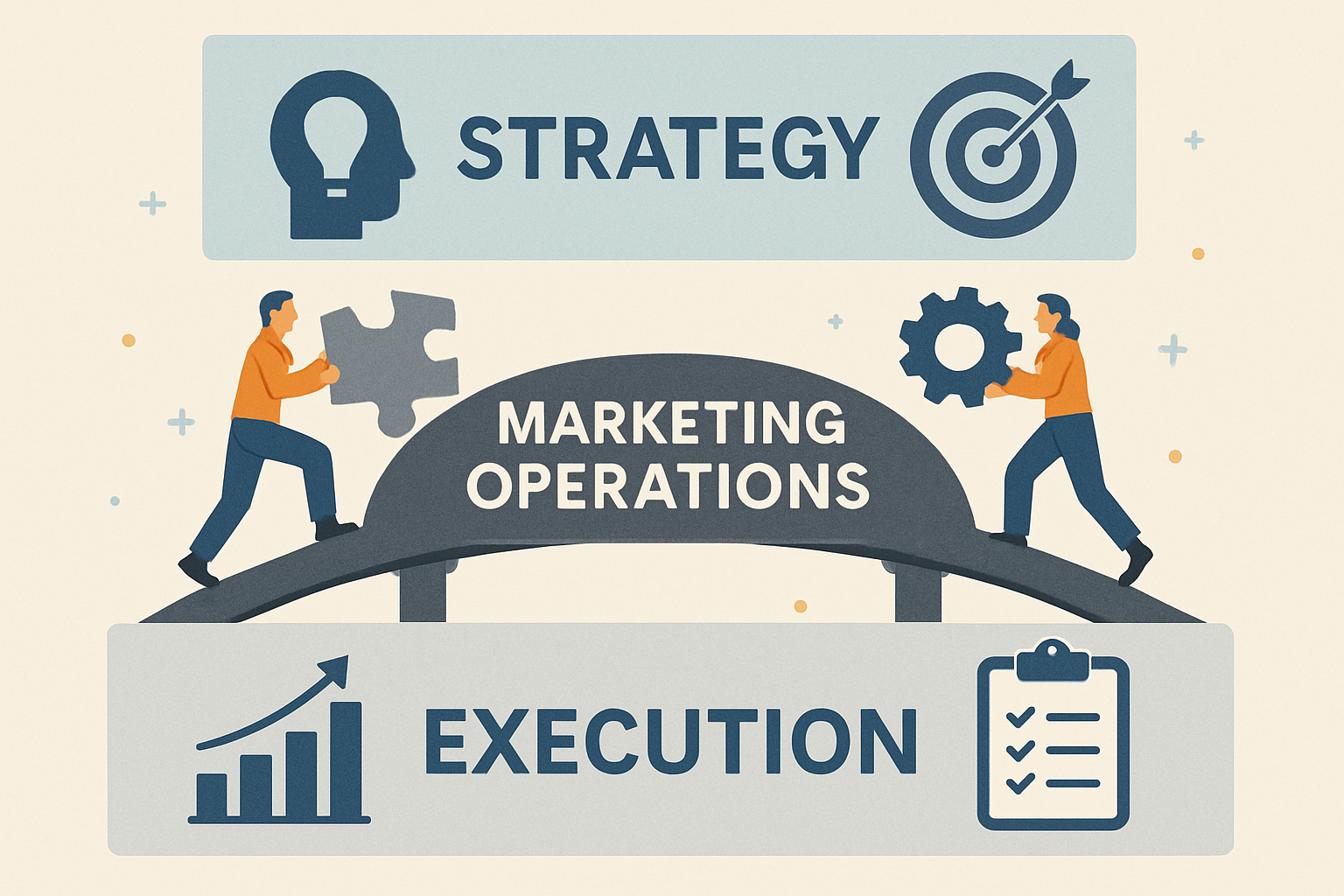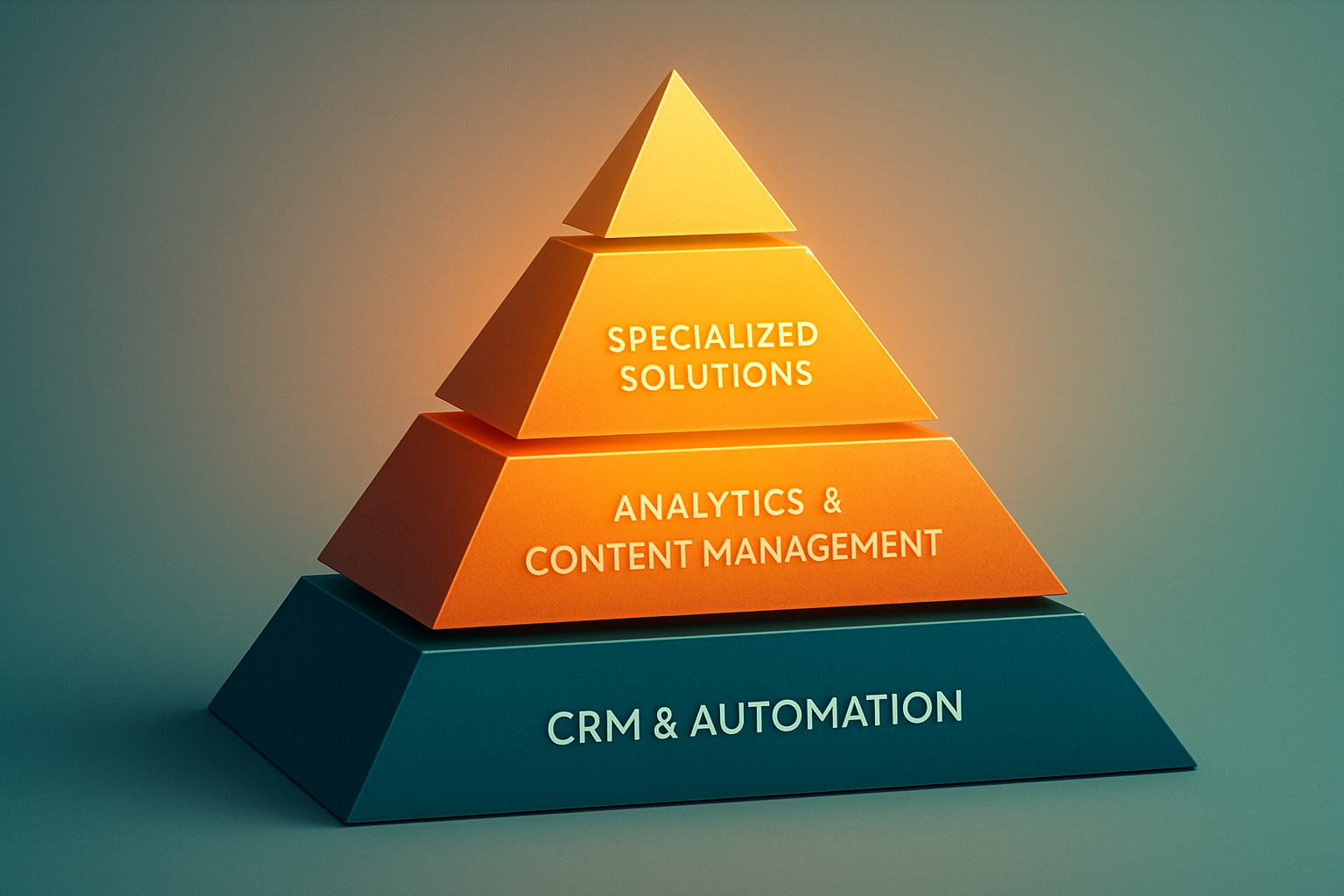Mastering Marketing Operations: Building a Framework for Scalable Success
Key Takeaways

Operational Excellence Foundation: Success in marketing operations requires mastering four core pillars, technology, data, team roles, and optimised workflows—all working together to deliver measurable outcomes.
Strategic Technology Alignment: Selecting and integrating the right marketing technology stack enhances automation capabilities, ensures data accuracy, and supports long-term scalability.
Clear Role Definition: Well-defined team roles enable accountability, foster cross-functional collaboration, and streamline campaign execution.
Process Optimisation: Streamlined workflows eliminate bottlenecks, reduce inefficiencies, and ensure consistent execution across teams and campaigns.
Centralised Data Management: Cohesive data strategies enable actionable analytics that drive more intelligent decision-making and improved campaign performance.
Continuous Improvement Culture: Regular assessment and refinement of marketing operations processes ensure adaptability to emerging challenges and technologies.
Automation Implementation: Strategic automation reduces manual tasks, creating more time for high-value strategic initiatives and innovation.
Strategy-Execution Balance: A practical marketing operations framework bridges high-level strategy with tactical implementation for cohesive, results-driven marketing.
Introduction: Why Marketing Operations Matter Now More Than Ever

In today's increasingly competitive business landscape, marketing success depends not just on creative campaigns but on the operational infrastructure that powers them. A robust marketing operations framework has become essential for organisations seeking to deliver consistent performance in an increasingly data-driven, outcome-focused environment.
Research from Gartner reveals that companies with mature marketing operations functions achieve 25% higher revenue growth compared to their peers with less developed operations. This stark difference highlights why marketing operations has evolved from a back-office function to a strategic imperative.
Failing to implement effective operations leads to predictable challenges:
- Wasted resources on disconnected initiatives
- Misaligned objectives across teams
- Missed market opportunities due to slow execution
- Inability to measure actual marketing impact
- Difficulty scaling successful campaigns
By contrast, well-designed marketing operations optimise processes, integrate technological capabilities, and empower teams to make smarter, faster decisions that scale with business growth. This comprehensive guide examines the key components of establishing a marketing operations framework that yields tangible business outcomes across various industries.
The Four Pillars of a Robust Marketing Operations Framework
![]()
Establishing world-class marketing operations requires addressing four critical pillars: processes, technology, data, and people. When these elements work in harmony, they enable seamless campaign execution, insightful measurement, and continuous optimisation.
1. Process Design and Standardisation: Creating Operational Efficiency
For any marketing team, well-defined processes form the foundation for sustainable operational efficiency. Even with advanced tools or top-tier talent, a lack of standardisation creates friction points that undermine performance. Documented processes serve as a clear roadmap for executing marketing tasks with maximum precision and minimal friction.
Practical Process Implementation Strategies
Workflow Mapping: Begin with a comprehensive audit of existing workflows related to campaign creation, lead management, and reporting. Use visualisation tools like Miro or Lucidchart to identify inefficiencies and redundancies.
Automation-Driven Improvements: Eliminate repetitive tasks through marketing automation platforms such as HubSpot, Marketo or Pardot. According to Forrester Research, marketing automation reduces marketing overhead by 12.2% while increasing sales productivity by 14.5%.
Governance and Compliance Protocols: Implement structured approval workflows to ensure brand consistency and compliance with regulatory standards, such as GDPR and industry-specific regulations.
Performance Measurement Systems: Establish clear KPIs for each process to enable ongoing evaluation and refinement.
Case Study: Process Transformation at Vodafone UK
Vodafone UK restructured their campaign development process by implementing standardised workflows and approval systems. This transformation reduced campaign launch time by 40% and increased campaign compliance from 76% to 98%, demonstrating how process standardisation directly impacts business outcomes.
Well-executed processes provide the scalability and flexibility marketing teams need to sustain high performance while adapting swiftly to new challenges.
2. Technology as the Operational Backbone
Modern marketing is inherently technology-dependent. With thousands of tools available, organisations need not only to adopt cutting-edge solutions but also to integrate them in alignment with their specific operational needs.
Crafting the Ideal Marketing Technology Stack
A carefully curated technology stack addresses core business functions while remaining adaptable to changing needs. When building your stack, focus on platforms that enhance efficiency and deepen insights:
Campaign Management: Systems like Salesforce Marketing Cloud, Oracle Eloqua, or HubSpot simplify CRM integration and enable omnichannel campaign coordination.
Content Development and Distribution: Tools such as Canva or Adobe Creative Cloud, combined with scheduling platforms like Hootsuite, streamline production and publishing processes.
Data Visualisation: Platforms such as Tableau and Power BI transform raw metrics into digestible, actionable visual insights.
Project Management: Solutions like Asana, Monday.com or ClickUp coordinate team activities and track deliverables.
Seamless Integration for Unified Operations
Disconnected tools lead to fragmented data and hinder collaboration. Ensuring seamless integration via platforms like Zapier, MuleSoft or native API connections ensures frictionless workflows, consistent reporting, and cross-team coordination.
A survey by Ascend2 found that 67% of companies cite "integrating disparate systems" as their most significant challenge in marketing operations. Addressing this integration challenge yields substantial benefits, as demonstrated by companies like Dell, where integrating their CRM system with other marketing tools led to an 18% improvement in lead-conversion rates through more targeted, data-informed campaigns.
Training and Accountability for Technology Adoption
Maximising your tech stack requires consistent training initiatives focused on skill-building and feature optimisation. Setting adoption metrics tied to business outcomes increases accountability and ROI from technological investments.
Implementation Tip: Create a technology roadmap that aligns tools with specific business objectives, including clear implementation timelines, training requirements, and success metrics.
3. Data Management: The Strategic Engine
Data, when managed efficiently, transforms from an operational by product into a strategic asset for decision-making. Whether in marketing, finance, or healthcare, leveraging data effectively is critical to delivering targeted solutions and measurable results.
Centralising Data for Unified Analysis
A centralised data hub or warehouse offers numerous advantages, including improved accuracy, consistency, and accessibility:
Platform Solutions: Implement solutions like Snowflake, Google BigQuery, or Amazon Redshift to facilitate real-time database integration, reducing duplication and enhancing reporting speed.
Overcoming Organisational Silos: Data silos can be mitigated through executive sponsorship and clear demonstrations of cross-functional benefits. According to McKinsey, companies that break down data silos see a 15-25% increase in marketing productivity.
Data Governance Frameworks: Establish clear protocols for data access, usage, and maintenance to ensure consistency across the organisation.
Ensuring Data Quality and Compliance
Data quality frameworks are crucial for establishing trust in analytics and insights. Effective methods include:
Validation Protocols: Implement AI-driven validation tools within platforms like Salesforce to minimise errors and inconsistencies.
Comprehensive Cleansing Strategies: Automate database hygiene with tools like Ringlead or Validity to maintain accurate customer information.
Regular Audits: Schedule quarterly data quality reviews to identify and address emerging issues before they impact performance.
Real-World Example: Spotify's Data Innovation
Spotify provides a leading example of data innovation, combining structured quality control with advanced machine learning for customer segmentation. Their approach has driven a 20% increase in subscriber conversion and a 15% boost in listener engagement, demonstrating how sophisticated data management directly impacts business results.
4. People: The Human Element of Marketing Operations
Even the most advanced tools and processes require an effective team structure to bring them to life. A blend of specialised roles and collaborative culture underpins successful marketing operations.
Defining Key Roles for Operational Excellence
A high-functioning marketing operations team typically includes these essential roles:
- Marketing Operations Manager: Oversees organisational strategy, technology development, and process optimisation. This role serves as the bridge between marketing strategy and execution.
- Campaign Manager: Drives end-to-end campaign delivery by aligning creative and strategic components while ensuring tactical implementation meets strategic objectives.
- Data Analyst: Extracts, interprets, and conveys actionable marketing insights that drive decision-making and campaign refinement.
- Automation Specialist: Configures workflows, manages integrations, and ensures the technology stack delivers maximum value and efficiency.
- Content Operations Specialist: Manages the content production pipeline, ensuring consistency, compliance, and efficient asset management.
Fostering a Culture of Adaptability and Growth
Given today's rapid technological evolution, fostering a culture of adaptability is critical. Strategies to develop such resilience include:
Upskilling Initiatives: Dedicate quarterly learning budgets for professional training in emerging tools and techniques. Companies that invest in upskilling see 24% higher profit margins, according to PwC research.
Incentivising Innovation: Create designated innovation funds for pilot testing unproven but high-potential initiatives.
Cross-Functional Collaboration: Establish regular touchpoints between marketing operations and other departments to align objectives and share insights.
Operational Excellence Example: Unilever's Marketing Academy
Unilever established a dedicated Marketing Academy that focuses on developing operational skills alongside creative capabilities. This programme has resulted in 30% faster campaign execution and a 22% improvement in campaign performance metrics, demonstrating the ROI of investing in people development.
Process Optimisation: Converting Efficiency into Results

Operational efficiency complements strategic creativity. By eliminating bottlenecks, teams can shift resources toward impactful, high-value projects that drive business growth.
Addressing Common Operational Bottlenecks
Strategies for resolving inefficiencies include:
Workflow Automation: Implement tools like Monday.com or Trello to automate scheduling, resource allocation, and approval processes.
Collaborative Planning: Schedule frequent alignment meetings to ensure cohesive campaign execution across departments.
Service Level Agreements (SLAs): Establish clear timelines for deliverables and approvals to maintain momentum.
Resource Optimisation: Use capacity planning tools to balance workloads and prevent burnout while maximising productivity.
Measuring Operational Improvement
Quantifiable metrics ensure process optimisation delivers tangible business impact:
Reduced Campaign Cycles: Measure the reduction in time from initial creative development to deployment. Top-performing teams have reduced this by up to 40% through operational improvements.
Improved Targeting Accuracy: Track data-driven improvements in campaign targeting precision. Companies with mature operations achieve an average 26% higher conversion rate.
Resource Utilisation: Monitor how team capacity is allocated between strategic and tactical work, aiming for at least 60% of time spent on high-value activities.
Cost Efficiency: Calculate the cost per lead or acquisition before and after process improvements to demonstrate financial impact.
Implementing Automation for Scalable Growth

Strategic automation represents one of the most powerful levers for marketing operations teams seeking to scale their impact. By identifying repetitive, time-consuming tasks that can be automated, organisations free valuable resources for strategic initiatives.
High-Impact Automation Opportunities
Lead Nurturing Workflows: Implement behaviour-triggered email sequences that move prospects through the funnel without manual intervention.
Content Distribution: Automate social media posting, email sends, and content syndication based on predetermined schedules.
Performance Reporting: Set up automated dashboards that pull real-time data from multiple sources, eliminating manual report compilation.
Data Synchronisation: Ensure customer data flows seamlessly between systems without requiring manual transfers or updates.
Automation Implementation Framework
- Audit Current Processes: Document existing workflows and identify tasks requiring significant manual effort.
- Prioritise Opportunities: Rank automation candidates based on potential time savings and strategic impact.
- Select Appropriate Tools: Choose automation solutions that integrate with your existing tech stack.
- Develop Clear Workflows: Map out detailed automation logic with clear triggers and actions.
- Test Rigorously: Validate automation performance in controlled environments before full deployment.
- Measure Results: Track time savings, error reduction, and throughput improvements.
Success Story: Ocado's Marketing Automation Transformation
UK online grocery retailer Ocado implemented a comprehensive marketing automation strategy that reduced campaign setup time by 65% while increasing email engagement rates by 38%. Their approach focused on automating customer journey workflows based on purchase history and browsing behaviour, demonstrating how automation can simultaneously improve efficiency and effectiveness.
Balancing Strategy with Tactical Execution

A practical marketing operations framework bridges high-level strategy with detailed, on-the-ground execution. This balance ensures marketing teams remain focused on business objectives while efficiently handling day-to-day implementation.
Creating Strategic-Tactical Alignment
Outcome-Based Planning: Structure operations around specific business outcomes rather than activities or outputs.
Cascading Objectives: Translate high-level goals into department, team, and individual objectives with clear connections.
Regular Strategic Reviews: Schedule quarterly operational reviews to ensure tactics continue to support strategic priorities.
Agile Methodology Adoption: Implement agile practices like sprints and stand-ups to maintain focus while enabling adaptation.
According to research from the Marketing Operations Cross-Company Alliance, marketing teams that effectively bridge strategy and execution achieve 17% higher return on marketing investment than those with a disconnection between these elements.
Building a Continuous Improvement Engine

Marketing operations excellence requires ongoing refinement and adaptation to ensure continued success. Establishing a formal continuous improvement mechanism ensures that operations evolve in tandem with changing market conditions and business requirements.
Continuous Improvement Framework
- Regular Performance Audits: Conduct quarterly assessments of operational efficiency, technology utilisation, and process adherence.
- Feedback Collection Systems: Implement structured ways to gather input from stakeholders about operational challenges and opportunities.
- Root Cause Analysis: When problems arise, dig deeper to identify underlying causes rather than addressing symptoms.
- Test-and-Learn Culture: Encourage small-scale experimentation with new processes or technologies before full-scale implementation.
- Knowledge Management: Document learnings, best practices, and process improvements in centralised, accessible repositories.
Future-Proofing Your Marketing Operations

As marketing continues to evolve, operations must adapt to emerging trends and technologies. Forward-thinking organisations are already preparing for these developments:
Emerging Trends in Marketing Operations
AI-Enhanced Decision Making: Artificial intelligence is increasingly being used to analyse campaign performance and recommend optimisation strategies automatically.
Privacy-First Data Strategies: With the deprecation of third-party cookies and stricter privacy regulations, operations teams are developing new approaches to data collection and activation.
Cross-Functional Integration: Marketing operations is expanding to connect more deeply with sales operations, customer service, and product development.
Skills Evolution: The required skill set for marketing operations professionals continues to expand, combining technical expertise with strategic business acumen.
Preparing for Operational Evolution
Technology Roadmapping: Develop an 18-24 month vision for your marketing technology stack that anticipates emerging capabilities.
Scenario Planning: Create operational contingencies for major industry shifts like privacy changes or channel disruptions.
Talent Development: Invest in cultivating both technical and strategic capabilities within your operations team.
Vendor Evaluation Framework: Establish clear criteria for assessing new tools and partners as the technology landscape evolves.
Conclusion: The Competitive Advantage of Operational Excellence

An optimised marketing operations framework, built upon the pillars of people, processes, technology, and data, enables organisations to navigate the complexities of modern marketing while driving scalable efficiency and producing measurable results. Embracing automation, robust integration systems, and cross-functional collaboration ensures seamless execution and adaptability.
As global trends such as artificial intelligence and tightened data privacy regulations redefine marketing ecosystems, businesses that adopt forward-thinking operational strategies will thrive. By combining core operational strengths with innovative approaches, organisations can effectively deliver immediate results while laying a strong foundation for sustainable growth and resilience in the ever-evolving marketing landscape.
The competitive advantage of superior marketing operations is clear: faster campaign execution, improved resource utilisation, more accurate measurement, and ultimately, stronger business performance. In a landscape where marketing complexity continues to increase, operational excellence isn't just a nice-to-have—it's an essential driver of marketing success.
Frequently Asked Questions About Marketing Operations

What is the primary role of marketing operations within an organisation?
Marketing operations serve as the infrastructure that enables the execution of marketing strategies. It encompasses the people, processes, technology and data management systems that allow marketing teams to plan, execute, measure and optimise their activities efficiently and effectively. The primary role is to create operational excellence that drives marketing performance while ensuring alignment with broader business objectives.
How do you measure the success of marketing operations?
Success metrics for marketing operations typically include efficiency measures (reduced campaign deployment time, resource utilisation), effectiveness indicators (improved conversion rates, higher ROI), and organisational impact (increased marketing-attributed revenue, better cross-functional collaboration). The most mature organisations develop balanced scorecards that combine these operational metrics with business outcomes to demonstrate full impact.
What skills are most important for marketing operations professionals?
The most valuable skills for marketing operations professionals include technical aptitude (proficiency in marketing technology), analytical capabilities (data interpretation and performance measurement), process design expertise, project management discipline, and strategic thinking. Increasingly, soft skills like change management, cross-functional communication, and leadership are equally crucial for driving adoption and alignment.
How should companies structure their marketing operations team?
Team structure varies based on organisation size and maturity, but typically follows one of three models: centralised (a dedicated operations team serving all marketing functions), distributed (operations specialists embedded within marketing teams), or hybrid (a core operations team with embedded specialists). The most effective approach aligns with existing organisational structure while providing clear accountability for operational excellence.
What technologies are essential for marketing operations success?
While specific tools vary by organisation, most effective marketing operations teams utilise marketing automation platforms, CRM systems, project/workflow management tools, data analytics solutions, and content management systems. Integration capabilities between these tools is often more important than the specific platforms chosen, as seamless data flow enables operational efficiency.
How can marketing operations better align with sales operations?
Alignment between marketing and sales operations requires shared goals, integrated systems, and collaborative processes to ensure effective communication and seamless execution. Best practices include implementing unified lead management workflows, establishing joint reporting dashboards, conducting regular alignment meetings, and creating shared service level agreements. When these functions work together, organisations see significant improvements in lead-to-revenue performance.

